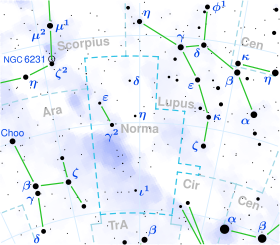| Observation data Epoch J2000.0 Equinox J2000.0 | |
|---|---|
| Constellation | Norma |
| Right ascension | 16h 34m 05.02028s[1] |
| Declination | −44° 02′ 43.1281″[1] |
| Apparent magnitude (V) | 4.91[2] (4.87 - 4.98[3]) |
| Characteristics | |
| Spectral type | O9.7Iab[4] |
| Apparent magnitude (U) | 4.05[5] |
| Apparent magnitude (B) | 4.99[5] |
| Apparent magnitude (J) | 4.74[5] |
| Apparent magnitude (H) | 4.679[6] |
| Apparent magnitude (K) | 4.612[6] |
| U−B color index | −0.84[5] |
| B−V color index | +0.05[5] |
| Variable type | Suspected α Cygni[3] |
| Astrometry | |
| Radial velocity (Rv) | +6.30[7] km/s |
| Proper motion (μ) | RA: 0.02[1] mas/yr Dec.: −1.98[1] mas/yr |
| Parallax (π) | 0.78 ± 0.33 mas[1] |
| Distance | 3,260 ly (1,000[8] pc) |
| Absolute magnitude (MV) | -6.45[2] |
| Details[9] | |
| Mass | 33.3[10] M☉ |
| Radius | 25[2] R☉ |
| Luminosity (bolometric) | 339,000[2] L☉ |
| Surface gravity (log g) | 2.90[2] cgs |
| Temperature | 28,000[2] K |
| Rotational velocity (v sin i) | 57[2] km/s |
| Age | 4.7[10] Myr |
| Other designations | |
| Database references | |
| SIMBAD | data |
μ Normae, Latinised as Mu Normae, is a blue supergiant star of spectral type O9.7 Iab, located in the constellation of Norma.
It shines as bright as 339,000 suns and is weighs 40 solar masses. It varies in visual magnitude between 4.87 and 4.98, and is suspected of being an Alpha Cygni variable, which are named after Deneb.
It is in the same direction and at the same distance as the faint open cluster NGC 6169, although it is brighter than the combined magnitude of all the other stars in the cluster. It was considered the prototype of the μ Normae class of open clusters by Collinder.[11]
References
[edit]- ^ a b c d e Van Leeuwen, F. (2007). "Validation of the new Hipparcos reduction". Astronomy and Astrophysics. 474 (2): 653–664. arXiv:0708.1752. Bibcode:2007A&A...474..653V. doi:10.1051/0004-6361:20078357. S2CID 18759600.
- ^ a b c d e f g Lefever, K.; Puls, J.; Aerts, C. (2007). "Statistical properties of a sample of periodically variable B-type supergiants" (PDF). Astronomy and Astrophysics. 463 (3): 1093–1109. arXiv:astro-ph/0611484. Bibcode:2007A&A...463.1093L. doi:10.1051/0004-6361:20066038. S2CID 8783008.
- ^ a b Samus, N. N.; Durlevich, O. V.; et al. (2009). "VizieR Online Data Catalog: General Catalogue of Variable Stars (Samus+ 2007–2013)". VizieR On-line Data Catalog: B/GCVS. Originally Published in: 2009yCat....102025S. 1: 02025. Bibcode:2009yCat....102025S.
- ^ Sota, A.; Maíz Apellániz, J.; Morrell, N.I.; Barbá, R.H.; Walborn, N.R.; Gamen, R.C.; Arias, J.I.; Alfaro, E.J. (2014). "The Galactic O-Star Spectroscopic Survey (GOSSS). II. Bright Southern Stars". The Astrophysical Journal Supplement. 211 (1): 84. arXiv:1312.6222. Bibcode:2014ApJS..211...10S. doi:10.1088/0067-0049/211/1/10. S2CID 118847528. 10.
- ^ a b c d e Ducati, J. R. (2002). "VizieR Online Data Catalog: Catalogue of Stellar Photometry in Johnson's 11-color system". CDS/ADC Collection of Electronic Catalogues. 2237. Bibcode:2002yCat.2237....0D.
- ^ a b Cutri, Roc M.; Skrutskie, Michael F.; Van Dyk, Schuyler D.; Beichman, Charles A.; Carpenter, John M.; Chester, Thomas; Cambresy, Laurent; Evans, Tracey E.; Fowler, John W.; Gizis, John E.; Howard, Elizabeth V.; Huchra, John P.; Jarrett, Thomas H.; Kopan, Eugene L.; Kirkpatrick, J. Davy; Light, Robert M.; Marsh, Kenneth A.; McCallon, Howard L.; Schneider, Stephen E.; Stiening, Rae; Sykes, Matthew J.; Weinberg, Martin D.; Wheaton, William A.; Wheelock, Sherry L.; Zacarias, N. (2003). "VizieR Online Data Catalog: 2MASS All-Sky Catalog of Point Sources (Cutri+ 2003)". CDS/ADC Collection of Electronic Catalogues. 2246: II/246. Bibcode:2003yCat.2246....0C.
- ^ Gontcharov, G. A. (2006). "Pulkovo Compilation of Radial Velocities for 35 495 Hipparcos stars in a common system". Astronomy Letters. 32 (11): 759–771. arXiv:1606.08053. Bibcode:2006AstL...32..759G. doi:10.1134/S1063773706110065. S2CID 119231169.
- ^ Fullerton, A. W.; Massa, D. L.; Prinja, R. K. (2006). "The Discordance of Mass‐Loss Estimates for Galactic O‐Type Stars". The Astrophysical Journal. 637 (2): 1025–1039. arXiv:astro-ph/0510252. Bibcode:2006ApJ...637.1025F. doi:10.1086/498560. S2CID 119339006.
- ^ Fraser, M.; Dufton, P. L.; Hunter, I.; Ryans, R. S. I. (2010). "Atmospheric parameters and rotational velocities for a sample of Galactic B-type supergiants". Monthly Notices of the Royal Astronomical Society. 404 (3): 1306. arXiv:1001.3337. Bibcode:2010MNRAS.404.1306F. doi:10.1111/j.1365-2966.2010.16392.x. S2CID 118674151.
- ^ a b Tetzlaff, N.; Neuhäuser, R.; Hohle, M. M. (2011). "A catalogue of young runaway Hipparcos stars within 3 kpc from the Sun". Monthly Notices of the Royal Astronomical Society. 410 (1): 190–200. arXiv:1007.4883. Bibcode:2011MNRAS.410..190T. doi:10.1111/j.1365-2966.2010.17434.x. S2CID 118629873.
- ^ Collinder, Per (1931). "On Structural Properties of Open Galactic Clusters and their Spatial Distribution. Catalog of Open Galactic Clusters". Annals of the Observatory of Lund. 2: B1–B46. Bibcode:1931AnLun...2....1C.

Well, that’s interesting to know that Psilotum nudum are known as whisk ferns. Psilotum nudum is the commoner species of the two. While the P. flaccidum is a rare species and is found in the tropical islands. Both the species are usually epiphytic in habit and grow upon tree ferns. These species may also be terrestrial and grow in humus or in the crevices of the rocks.
View the detailed Guide of Psilotum nudum: Detailed Study Of Psilotum Nudum (Whisk Fern), Classification, Anatomy, Reproduction